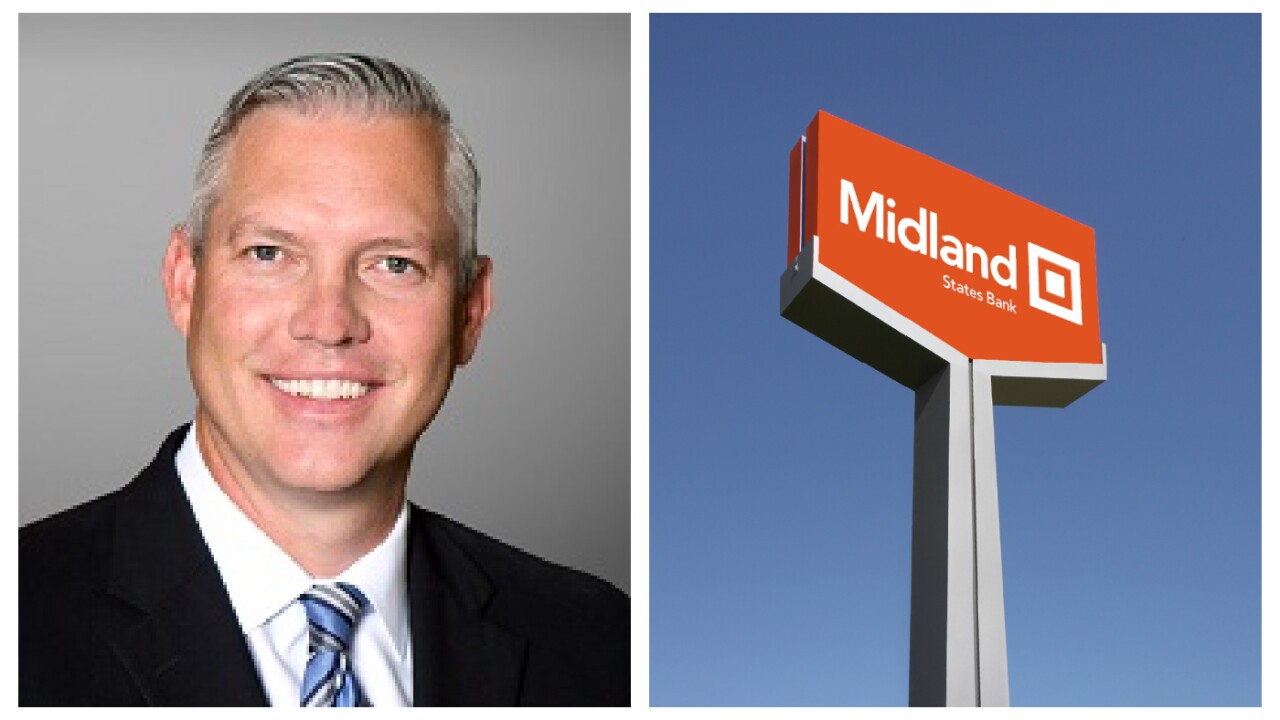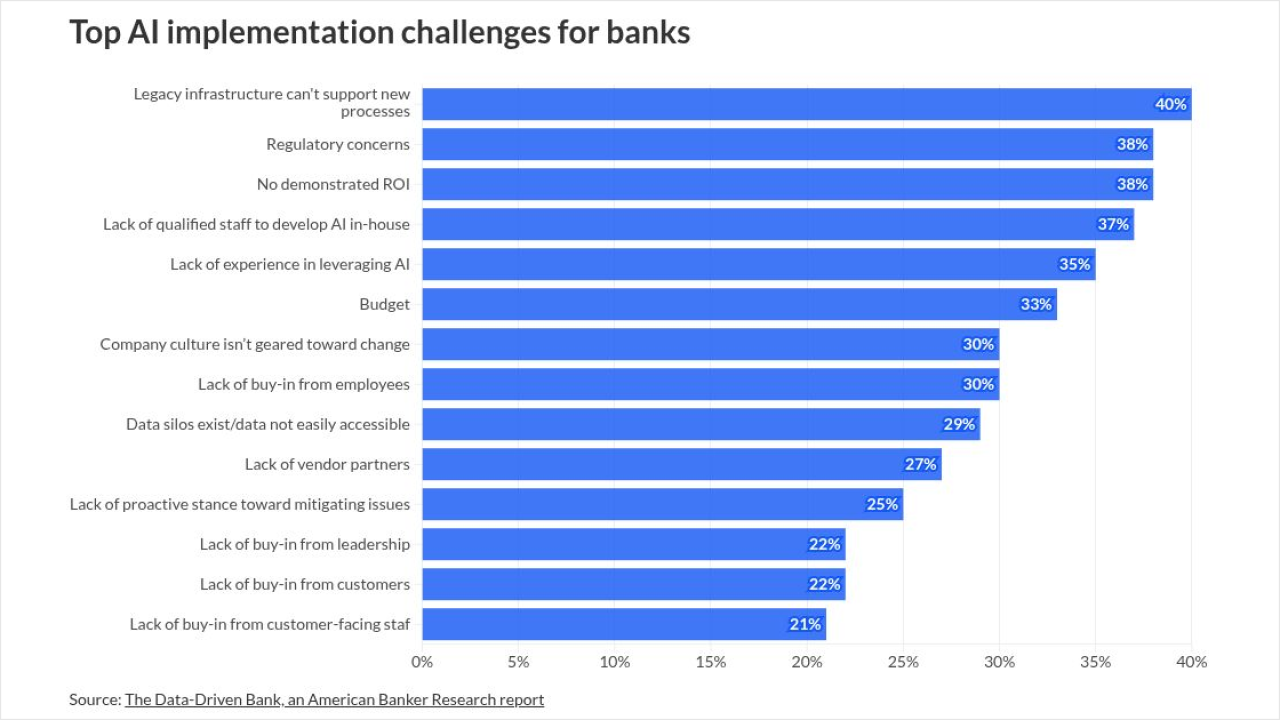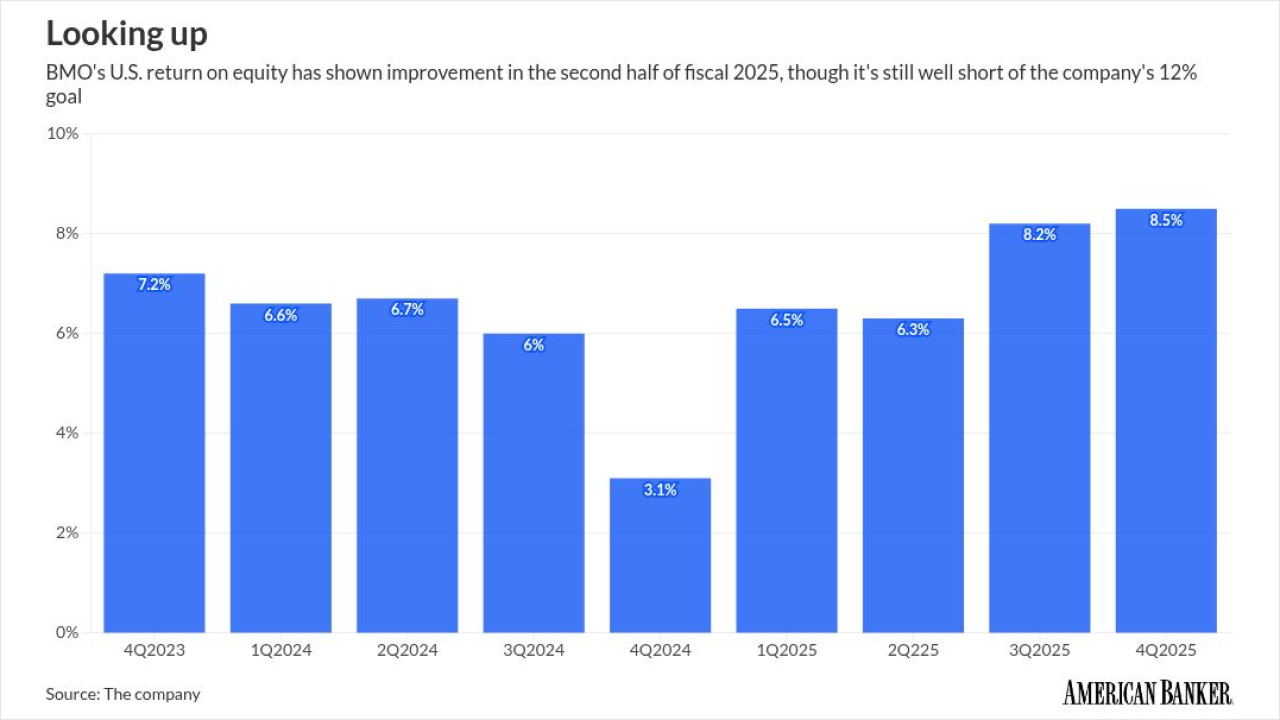-
Disciplined pursuit of acquisitions and efficient management of a complex business model have earned Mick Blodnick, the retiring CEO of Montana's largest bank, a spot as one of American Banker's three community bankers of the year.
December 18 -
Ed Clark took Toronto-Dominion Bank from nowhere in the U.S. to the nation's 15th-largest bank holding company in a single decade but his even-keeled, conscientious leadership philosophy is perhaps his most valuable legacy.
December 15 -
Trevor Burgess, CEO of C1 Financial, brings an investment banker's irreverence to the normally decorous business of community banking. But he's produced a record that backs up his brash talk.
December 14 -
Where there's a will, there's a way for Chris Bauer, who guided Anchor through bankruptcy as a means of recapitalizing the once-struggling Wisconsin company. The turnaround was punctuated with the company's October IPO.
December 16
It's a good thing James Herbert 2nd didn't follow his dad's career advice when he graduated from college in the mid-1960s.
The elder James Herbert was running the Lorain National Bank in Ohio at the time and strongly encouraged his son to pursue a career outside of banking. But if he had listened, he never would have founded First Republic Bank in the mid-1980s and built it into a premier private bank, beloved by its clients for delivering off-the-charts-service. Bank investors never would have reaped the rewards of the bank's uninterrupted run of profitable years, scoring big in 2007 when the bank was sold to Merrill Lynch for $1.8 billion.
And Herbert certainly never would have been able to pull off one of the great second acts in banking history in July 2010, when he and some private-equity investors bought the bank back from its new owner, Bank of America, and took it public five months later.
There were some detours on the way to his current role as chairman and chief executive of the $46.7 billion-asset First Republic. Between the time he entered Chase Manhattan's credit training program out of Babson College and founded his first bank startup some 15 years later, Herbert, at various times worked as an investment banker in New York, ran a small steel manufacturing firm in Cleveland and even headed a soft drink bottling company in Richmond, Va.
But banking is in Herbert's blood, and after returning to the business in 1980 he never looked back.
"My dad told me not to go into banking, but I grew up around it and I liked watching what he did," Herbert explained. "He made a lot of difference in" people's lives.
Today, at 70 years old, Herbert is at the top of his game. Since
Meanwhile, credit quality always a strength remains as pristine as ever. At Sept. 30, its ratio of nonperforming assets to total assets was a measly 0.11%.
How is First Republic doing it, at a time when all banks are struggling to increase revenues and competition for quality loans is so fierce that they are starting to
Obviously, it helps that First Republic is a private bank with well-heeled clientele who are likelier to pay their loans. Geography also helps; the bank's primary markets of San Francisco, Los Angeles, New York and Boston, are more affluent and dynamic than most other regions of the country.
But what really sets it apart from its peers, customers say, is its commitment to service.
If a client is rushing off to Europe and forgot to get euros, her First Republic banker will meet her at the airport with the funds. If he needs to make changes to a certain trust account, First Republic will fill out all the forms and paperwork, then either hand-deliver or overnight it for the client to sign.
At a large bank, "they'll send the forms to you and it will take you four hours to fill them out," said Craig Sullivan, the former CEO at Clorox and a longtime First Republic client. "First Republic will take care of everything. They are all about service."
Steven Alexopoulos, the managing director of mid- and small-cap bank equity research at J.P. Morgan, said that while many banks view themselves as relationship-focused, few are as committed to their clients as First Republic. The best indicator of that: much of First Republic's new business comes from customer referrals.
"Most customers tolerate their bank," Alexopoulos said. First Republic "is one of the few brands in the bank world where clients are passionate about the company and proactively refer their colleagues."
For building First Republic into one of nation's most profitable banks, while remaining disciplined on credit and exceeding expectations for service, Herbert has been named American Banker's Banker of the Year for 2014.
It's an unconventional pick for us, given the bank's size, its focus on high-net-worth clients and relatively narrow set of products. Most recent honorees, which have included
First Republic is not that kind of bank. Its clients are largely affluent, urban professionals; the firms and businesses for which they work; and the nonprofits they support. It provides jumbo mortgages, commercial loans, trust services and wealth management, but it doesn't offer credit cards or car loans. First Republic steers clear of any type of investment banking or trading activity. A client who needs a letter of credit to execute an overseas trade will have to get it from another bank.
Still, now more than ever, banks need to distinguish themselves in some way. First Republic has done that by hiring smart, personable bankers and training them to always put the client first. Pay them well, empower them to make decisions, and relationship managers will do right by clients and not always be looking for a promotion or the next job opportunity, Herbert said. Indeed, some of its current relationship managers joined the bank around the time it was founded. Many others have been there for a decade or more.
"Our turnover is low because we hire people who don't want to run the world. They just want to serve clients," Herbert said during an interview at the bank's East Coast headquarters in Manhattan.
This commitment to service shows up in metrics like attrition rate and
Its net promoter score, which measures customer loyalty, is 55% overall and 74% if First Republic is the client's lead bank up there with such iconic brands as Apple, Nordstrom and Ritz-Carlton. The average net promoter score for the rest of the banking industry is 18%, according to a 2013 report from Greenwich Associates.
To Herbert, taking care of clients' needs makes good business sense. "Why spend money to go out and find new clients?" he said. "Just take good care of the ones you have."
Russ Flynn, a San Francisco real estate investor and longtime First Republic client, has relationships with several banks and says the attention he gets from First Republic is, hands down, the best.
"I have a personal banker I've had for 15 years and there isn't a week that goes by that I don't get a touch, a feel or a reach-out," he said.
Sullivan first became a First Republic customer when he took out a home mortgage with the bank in the late 1990s. So pleased with the service he was receiving, he soon moved his deposit accounts to the bank and later, after retiring from Clorox, turned to First Republic to manage his wealth. Like Flynn, he has referred many friends, colleagues and business associates to First Republic.
"When you get good service today it's such an exception that you just want to tell everybody about it," said Sullivan.
Young Entrepreneur
In some ways, it's surprising that Herbert has held the same job now for 30 years given how restless he seemed in his younger days.
He started college at Miami University in Ohio but transferred to Babson after a year because he wanted to experience life out of state. He moved on to New York, where he worked at Chase Manhattan and received his MBA from New York University at night, then to the Caribbean, where he was a credit training officer, and then back to New York to work in the bank's international department.
He left Chase around 1970, moving on to the investment house Newburger Loeb & Co. When one of the firm's investments in a steel company soured, Herbert was sent to Cleveland to work it out, becoming Newburger's "titular" president, as far as the steel firm was concerned. He was in his mid-20s at the time.
Herbert turned the steel company around and sold it to a competitor. In the meantime Newburger Loeb was sold. So Herbert stayed in his home state and took a job at Citizens Financial in Cleveland, running its mortgage bank and several other business lines. He was in his late 20s and had roughly 90 people reporting to him, but he quickly grew antsy and quit after just two years on the job.
"I wasn't doing business. I was managing all the time and that's not who I am," Herbert said.
Herbert briefly worked as a real estate financier in Texas, but the state's economy tanked when the 1970s oil crisis hit, so he moved back to New York to look for his next opportunity. Through a business acquaintance, he ended up buying a soft drink bottling plant in Richmond, where he spent three years, and then another in San Francisco, before selling them to an affiliated firm.
By then it was 1980 and Herbert, now married and with a young family, was ready to re-enter banking.
He bought an industrial loan charter, parlayed that into a startup lender in Sunnyvale, Calif., and carved out a niche making jumbo mortgage loans in the high-priced San Francisco and Silicon Valley markets.
It was a business few banks dared enter the loans were too large to sell to Fannie Mae or Freddie Mac but Herbert made it work through disciplined underwriting. For example, a borrower would not be considered for a loan unless he could put down 50% toward the purchase price. Even today, the average loan-to-value ratio on a First Republic jumbo loan is about 60%.
"We made about 2,500 home loans and in four years we had just four losses," Herbert said. "We had very tight underwriting and that's been the backbone of our business since."
Herbert sold the company, San Francisco Bancorp, in 1984 and formed First Republic less than a year later. Its business model was similar. It took savings deposits and made jumbo loans. But by the mid-1990s, clients started wanting more from the bank as mergermania swept California and many local banks were swallowed up.
So the bank switched from a California thrift and loan charter to a Nevada state banking charter, a move that allowed First Republic to offer full-service checking.
"The second that opened up, deposits just poured in," Herbert said. "Existing clients just brought everything over."
That's also around the time First Republic started counting products per client. At that point, a client had an average of 1.2 products with the bank, but as it methodically added new capabilities over the next decade checking, brokerage, wealth management, commercial lending and commercial real estate lending those numbers started to climb.
Today, the average First Republic customer has eight products with the bank. The industry average, according to various studies, is closer to four.
Flynn, the San Francisco real estate investor, was an early customer of San Francisco Bancorp and First Republic. Service, he said, was always exceptional, but on more than one occasion he became so frustrated with Herbert's cautious underwriting that he stopped doing business with his banks.
"They lost me for a while," Flynn said. "I felt they were just too conservative."
Indeed, First Republic is so strict with its underwriting that it often won't make a loan unless it's to an existing client or to someone referred by an existing client. The bank has also taken the concept of
"If a loan goes bad in first three or four years, you take the first hit," Herbert said. "And if you made X on that loan, we will claw back between four and six times that."
The benefits of the policy, which has been in place since day one, are that lenders pay ultraclose attention to credits and learn how to work out loan problems if they develop, Herbert said.
It's also a good way to screen job candidates.
"People you are interviewing always know their credit history better than you do," said Herbert. "If they see there's a clawback they may not come in for that next interview."
Make no mistake, though: First Republic does lend. A lot. In fact, its loan-to-deposit ratio is a robust 103%, compared to the industry average of 69% as of Sept. 30.
Merrill Lynch Merger
With its pristine credit quality and an attractive customer base, First Republic had long been an alluring takeover target. In 2007, Merrill Lynch came knocking.
At first, Herbert wasn't interested in selling. But he and the board eventually concluded that the client bases were similar and that a merger made sense for First Republic's clients and employees. The price, a roughly 44% premium over First Republic's stock valuation at the time, wasn't bad, either.
A condition of the deal was that the First Republic brand, staff and management team, including Herbert and longtime president Katherine August-deWilde, would remain intact. That proved to be a wise move. First Republic thrived under Merrill, posting a record profit in 2008, even as the parent company was teetering on the brink of collapse and had to be rescued by Bank of America.
The marriage with Bank of America was an odd one, though, because B of A had a competing brand in U.S. Trust. So in early 2009, Herbert began exploring the option of buying the bank back.
B of A was on board. It needed to sell assets to raise capital. But Herbert still had to sell the plan to regulators who, at the time, were leery of granting new bank charters and might not have been too keen on seeing valuable assets leave B of A.
"There were times when it looked like it wasn't going to happen, but Jim never lost his focus," said deWilde, who was Herbert's first hire at First Republic back in 1985. "He worked very, very hard with regulators to get it done."
With backing from two private-equity groups, Colony Capital and General Atlantic, Herbert raised roughly $1.8 billion to reacquire First Republic.
Bill Ford, General Atlantic's CEO, said he barely hesitated when Herbert approached him about helping to finance the buyout. General Atlantic typically does not invest in banks, but Ford saw it as an opportunity to back what he described as "a special bank" and "an extraordinary leader."
"We think Jim is one of the best and most entrepreneurial bankers of his generation," Ford said. "He's the whole package as a CEO. He's very good strategically, has a very good understanding of the forces that are affecting his business, he has a clear vision of what First Republic stands for with its customers, and he's established a fantastic credit culture."
General Atlantic cashed out of its investment when the bank went public in December 2010 earning a roughly 70% return but Ford was so enthused about the direction of the bank that he stayed on its board.
What's Next
If there's anything about First Republic that concerns its investors it's the costs of becoming a "systemically important financial institution."
At its current rate of growth, the bank will cross the $50 billion threshold late next year or early 2016. When the bank announced in July that it's spending millions of dollars a quarter to prepare for the increased regulatory scrutiny, the stock fell 15% in one day.
Herbert, though, said the investment in new people and more sophisticated systems will only help the bank as it gets larger. Indeed, many of the executives it has hired in the last two years or so are from larger banks, with extensive experience in areas like Bank Secrecy Act compliance and enterprise risk management.
"There's a lot of work, there's a lot of effort, there's a lot of reporting, but all of this will help the enterprise," Herbert said.
Other banks nearing the $50 billion mark have said publicly that they are eyeing large acquisitions to justify the additional compliance costs, but Herbert is content growing First Republic organically. First Republic has made only one bank acquisition in its history, and Herbert said he's unlikely to pursue other bank deals because he doesn't like the "cultural risk." (The bank did buy a wealth advisory firm, Luminous Capital, in 2013.)
The bank doesn't need to do deals, he said, because he believes there is plenty of room to grow in the markets it now serves.
"The markets we are in are enormous, and we just have a modest share," he said.
As for his own future, Herbert's CEO contract runs to mid-2017. Even if he steps aside then, as planned, he would remain the bank's chairman. Until then, he has no plans to slow down.
Herbert shuttles between San Francisco and New York, where he is on the board of Lincoln Center, and still spends roughly a quarter of his time with customers.
"Jim has so much energy and so much passion for the business," said Ford. "He's back and forth between both coasts and he is constantly with customers that's how he gets information about how the bank is doing. I don't see him slowing down."
Frank Fahrenkopf, a longtime First Republic board member who chaired the Republican National Committee in the 1980s, agreed.
"We expect Jim to be around for a long, long time," he said.





